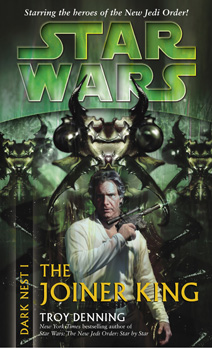Call him the Stephen King of “Star Wars” authors. No other scribe has a bigger gap between his lows and highs than Troy Denning. I recently criticized his debut effort, “Star by Star” (2001), in my “New Jedi Order” re-read, but “Tatooine Ghost” (2003) was better and “Dark Nest I: The Joiner King” (2005) – the first of a trilogy – is an outright great novel.
Part of my new appreciation for Denning is that I’ve adjusted to his writing style, but mostly, he has improved over the course of three “Star Wars” books. One thing that sets him apart from other “Star Wars” writers is that he doesn’t deliver dramatic spikes at regular intervals, nor does he accentuate the most important moments. For example, “The Joiner King” drops the bombshell that the Killiks – a species that supposedly went extinct on Alderaan long before humans settled the planet – still exist, but it does so very casually. Han and Leia realize these insects resemble those in the painting above their bunk, “Killik Twilight,” so everyone refers to them as Killiks from that point forward.
Another thing I had to get used to is that Denning often has multiple things happening at once. For instance, Han and Leia will be conversing via comm with Kyp about one issue even as they are being shot at by a pursuing ship as part of another issue. Each chapter ends on a grace note, when the author feels he’s delivered enough information in that scene – or perhaps he senses a reader’s exhaustion, something he wasn’t dialed into in the overlong sequences of “Star by Star” and “Tatooine Ghost.”
Denning’s books require focus in order to pick out the juicy details. That’s hard when the material isn’t great, as with “Star by Star” – which is basically just one endless battle scene — but “The Joiner King” is an engrossing read on several levels. First, Denning analyzes the always-timely debate between collectivism and individuality, giving it a personal touch in the form of Jaina Solo. Along with Zekk, Lowbacca, Tekli, Tesar, Tahiri and Alema, she has taken the side of the Killiks in their border dispute with the Chiss in the Unknown Regions.
A reader feels a parent’s disappointment and worry when one of their children joins what appears to be a cult; this is most starkly illustrated when Han and Leia observe Jaina, Zekk and Alema participating in a ritual Killik dance where they rub forearms with the insectoid aliens’ mandibles. The scene is also a prime example of the humor – ranging from dark to light – smoothly integrated into “The Joiner King.” Jaina’s joining also gives us a love triangle: While she still loves Jag deep down, the bond of the Nest brings her closer to Zekk, since his feelings toward her are also her feelings when she’s tapped into the collective mind.
In a broader sense, the danger of collectivist thinking is illustrated by the very existence of the Chiss versus Killik conflict. Both species are known for being peaceful. The Killiks protect their hive planets with dartships, but then they nurse injured captives back to health. The Chiss, meanwhile, have an official doctrine that they won’t go to war unless they are attacked first. And yet, there somehow is a war going on, something that provides an undertone of mystery until our heroes realize the Killiks are harboring a Dark Nest among them. The titular Joiner King, the Jedi Raynar Thul, doesn’t know about the Dark Nest because Dark Jedi Lomi Plo and Welk (last seen in “Star By Star,” as was Raynar) are hiding its existence from his mind, and therefore from the entire hive mind.

Peripherally related to the theme of collectivism, we get some good scenes illustrating the conflict between two organizations: the Galactic Alliance and the Jedi Order. Kyp says the Jedi serve all sentients, even those outside the GA’s borders, because – even though the GA funds them – the government agreed to that condition. Corran Horn, a former CorSec officer, says the Jedi serve the GA first because that’s who is paying their bills. Personally, I lean toward Corran’s point of view: If the Jedi want to operate outside of the GA’s jurisdiction, they need to stop accepting funds from the government and instead operate on free-will donations; Luke and the other masters may be above conflicts of interest, but frankly, it just looks bad.
(On the topic of funding: How do Leia and Han make money? Neither has day jobs, and neither is currently employed by the government or military, although they constantly volunteer to help. Since they live on the Falcon, their cost of living is lower than if they lived in a Coruscant apartment. But still, Leia must have smartly invested her previous Chief of State paychecks. Or perhaps they aren’t completely volunteers, but rather are given stipends by the GA.)
While Han’s worry about his daughter’s path is universal, there’s also a personal element that illustrates Denning’s knowledge of EU lore, which has always been solid: Han Solo hates bugs. While casual readers will be reminded of Indiana Jones’ hatred of snakes, Han’s dislike of hive-minded insectoid species dates back to a couple of Brian Daley works: “Han Solo’s Revenge,” where he and Chewie run afoul of Kamarians (something Denning references), and the 33 rpm record “Rebel Mission to Ord Mantell,” where Han is uneasy dealing with a Rebel operative who is a member of the Nalrithian species.
And although it doesn’t involve Han, any “Star Wars” story about insects will call to mind the Geonosians, who have a parallel with the Killiks in that they seem to have been completely wiped out in the “Rebels” TV series.
Other nice EU tie-ins include the intimation – perhaps to be explored later in this trilogy – that the Killiks created the Maw and Centerpoint Station. Also, the “X-Wing” novels toyed with the idea of an Ewok space pilot – both as an in-joke among Rogue Squadron as a part of the experiment that leads to the super-smart Gamorrean, Piggy – but Denning flat-out does introduce an Ewok pilot named Tarfang. While an explanation of Tarfang’s existence would’ve been welcome, the established lore does provide some verisimilitude, at least.
The piece of continuity I remembered most from my initial read is Luke discovering recordings of Anakin, Padme and Obi-Wan – basically cut scenes from “Revenge of the Sith” — in Artoo’s memory banks. Along with Leia finding Shmi’s journal in “Tatooine Ghost,” Denning is the king of helping Luke and Leia connect with the generation before them. I love the way Denning shows Artoo’s desire to hide these recordings from Luke – no doubt feeling he will learn something hurtful – while couching it in the fact that the astromech droid has developed quirks in his circuitry.
Denning isn’t always a master character writer. His Han-and-Leia interactions feel stiffer and sharper than they should be, whereas they had developed the conversational flow of an old married couple in the latter “NJO” books. And I can see that he’s trying to make the eager Sullustan Jae Juun into Han’s new copilot, but even the author himself seems to tire of the concept as the book goes forward and the plot thickens.
There are a lot of high points, though. He is responsible for inventing two of the best prominent post-“Return of the Jedi” characters: the Barabel Saba Sebatyne, who loves to hunt and who agrees to take on Leia as an apprentice at the end of this book; and Alema Rar, who in “The Joiner King” becomes what Luke always suspected she would – a Dark Jedi, as she never did recover from the loss of her sister, Numa, in the Yuuzhan Vong war.
Denning delivers some good Jacen Solo writing here, although he’s a side character. Jacen has been traveling the galaxy for five years searching out other perspectives on the Force – something Luke did back in the “Black Fleet Crisis” trilogy and something Luke and Ben will do again in “Fate of the Jedi,” retracing Jacen’s path for clues of how and why he turned evil. At this point, he’s so confident and skilled in the Force that when Cilghal hooks all the young Jedi up to brain scanners, Jacen toys with his, making colorful patterns with his mind. Unlike his colleagues, he is above the influence of the Killik hive mind.
“The Joiner King” introduces Ben Skywalker as a full-fledged character – he is 8 years old – and an immediately compelling one. Having been born during the Yuuzhan Vong war, he developed a habit of withdrawing from the Force. This worries his parents, as does the fact that the influence of Ben’s Killik “friend” makes him accuse Mara of being a killer. As such, we get the best Mara characterization in a long time as she must try to explain to Ben how she has killed beings yet works for galactic peace.
One oddity in “The Joiner King” is that whenever Denning illustrates the size of something, it’s always “thumb-sized” – as in, the planet looked thumb-sized from Han’s perspective in the Falcon’s cockpit. As soon as I noticed this tendency, it took me out of the narrative flow several more times.
Overall, though, “The Joiner King” is a big step forward for Denning, and it ultimately alleviated my fears that the Killik-Chiss war would take up a whole, overwritten trilogy. Rather, the conflict is resolved in this book (which admittedly is pretty thick, at 443 pages). Aside from the ongoing mysteries about the Killiks’ past and disappearance, Luke’s desire to find more of Artoo’s recordings, and the threat of two surviving Dark Jedi (Alema and Lomi Plo), “The Joiner King” works as a standalone novel. But it also has me mulling those lingering threads.

